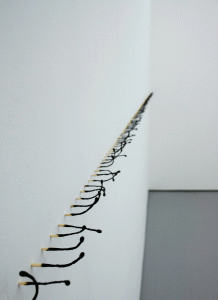« Reviews
Diferido - Diogo Pimentão

Diogo Pimentão, Desenho (detail), 2009, wood and charcoal, variable dimensions. Collection of António Cachola/Museu de Arte Contemporânea de Elvas (MACE). Photo courtesy of MARZ – Galeria, Lisbon
MARZ Galeria - Lisbon, Portugal
By Ekaterina Rietz-Rakul & Steve Schepens
Drawing is the main medium of young Portuguese artist Diogo Pimentão. However, Pimentão (like the artists of arte povera) refuses to stay traditional and seems completely open toward new materials and processes. The artist widely uses the method of alienation, or Verfremdung. The technique, popularized by Brecht, consists of creating new meanings by putting well-known facts or attitudes into unexpected contexts. He widens the horizons of drawing, showing great respect for all drawing tools - actual, potential or primordial. Stones, bones, charcoal, paper and pencils are exhibited on equal terms with works of art they facilitated.
In his world, paper and pencils-draftsman’s main tools-cease being mere instruments used in a fixed or routine way to create art. Utilizing them in a non-traditional manner, the artist either ascribes new properties to the materials or sheds light on the secondary ones, those which are usually not associated with them. His subtle sculptures look like drawings, and solid drawings look like sculptures.
Pimentão’s drawing loses its lightness and evanescence. The artist lets the paper disappear under numerous layers of fine pencil strokes or dots. He creates sculptural works from paper, thoroughly covered with pencil, twisted and mounted on the wall. One of the works-a life-sized drawing of a suit-strongly reminds us of Joseph Beuys’ Filzanzug. If the latter might be seen as an opaque form of self-portrait, the graphite portrait of Pimentão is more daring and playful, revealing a pair of socks and underwear; its glossy coldness opposed to the physical and conceptual warmth of Beuys’s Felt Suit.
Whereas presented drawings look solid, the objects and sculptures are of striking fragility-a row of burnt matches stuck in the wall, a tower of little ornate cubes in colored pencil, colorful rags made out of tiny chips of chopped pencils, backbones of books with torn-out pages.
None of exhibited works are tightly fixed or protected. The viewer is constantly alerted by the closeness to fragile and unusual artifacts, which might be destroyed by a gust of air or an inadvertent move.
(November 13, 2009 - January 9, 2010)
Ekaterina Rietz-Rakul and Steve Schepens are based in Berlin, Germany. Rietz-Rakul is a freelance writer and translator. Schepens is a visual artist and an arts writer.
Filed Under: Reviews


































